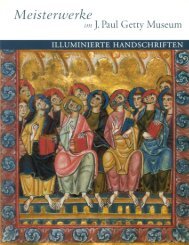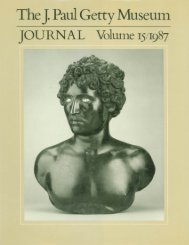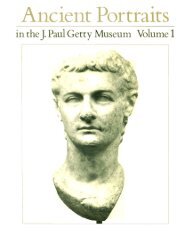The J. Paul Getty Museum Journal Volume 5 1977
The J. Paul Getty Museum Journal Volume 5 1977
The J. Paul Getty Museum Journal Volume 5 1977
You also want an ePaper? Increase the reach of your titles
YUMPU automatically turns print PDFs into web optimized ePapers that Google loves.
Fig. 3: Tufa Sphinx Vienna, Private Collection<br />
That the <strong>Getty</strong> sphinx and the Vienna sphinx were<br />
originally seated rather than standing sphinxes, is<br />
testified by more complete examples and, 9 to a large<br />
extent, by a series of winged lions carved in nenfro. Two<br />
lions which can be dated to the early years of the 6th<br />
century B.C., one in the Ashmolean <strong>Museum</strong> with its<br />
wings missing (Fig. 5), 10 the other from Vulci with sickle<br />
wings yet preserved, (Metropolitan <strong>Museum</strong> of Art, Fig.<br />
6), 11 show striking similarities with the <strong>Getty</strong> sphinx in<br />
the rendering of specific details on the body. <strong>The</strong> deeply<br />
modelled horizontal planes at the sides of the lion's<br />
body are reflected by the incised lines on the <strong>Getty</strong><br />
sphinx. In addition, they possess the same broad curved<br />
band which, judging by the New York lion, represents<br />
the upper edge or border of the wing. For the decorative<br />
treatment of the area from the shoulder muscles down<br />
to the forelegs, the Ashmolean lion offers a particularly<br />
Fig. 4: Tufa Centaur from Vulci Rome<br />
close analogy to the <strong>Getty</strong> sphinx. 12<br />
On the evidence of the close proximity in style<br />
between the heads of the <strong>Getty</strong> sphinx and the Vulci<br />
centaur and the analogies drawn with the winged lions,<br />
the <strong>Getty</strong> sphinx may be a product of a Vulci workshop<br />
and dated to the first quarter of the 6th century B.C.<br />
9. Notizie degli Scavi di Antichita 1931, p. 234, fig. 4; U. Tarchi,<br />
L'Arte Etrusco-Romano nelVUmbria e nella Sabina I (Milan, 1936),<br />
pll. II, HI; A. Hus, pi. XXXVI, 34; Bull ofMFA LXII (1964), p. 108,<br />
fig. 9; and D. Strong, <strong>The</strong> Early Etruscans (New York, 1968), p. 61.<br />
10. Oxford, Ashmolean <strong>Museum</strong>, inv. no. 1963.32; See Bull ofMFA<br />
LXII (1964), p. Ill, fig. 14.<br />
11. New York, Metropolitan <strong>Museum</strong> of Art. See Bull ofMFA LXII,<br />
(1964), p. 112, fig. 16; Bulletin of the Metropolitan <strong>Museum</strong> of Art,<br />
October, 1960, p. 45; and E. Richardson, pi. XVII.<br />
12. Note the same area on the winged lion in Boston, inv. no. 61.131:<br />
Bull ofMFA XLII (1964), p. 112, fig. 15.<br />
47








